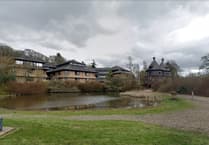New-look constituencies for mid and north Wales will go to a final four-week consultation before being introduced at the next general election, the Boundary Commission for Wales has said.
Initial proposals to cut the number of Welsh seats in the House of Commons from 40 to 32 – with Westminster constituency sizes increasing and elector numbers levelling out – were revealed last year and went through an eight week consultation.
The Boundary Commission for Wales released its final proposals on Wednesday.
The plan will see Ceredigion take on part of the axed Preseli Pembrokeshire seat, to create Ceredigion Preseli.
Also under the plans, the Montgomeryshire constituency, which is home to Machynlleth and Llanidloes, will be enlarged to take on parts of Clwyd South to become Montgomeryshire and Glyndŵr.
An extended Dwyfor Meirionnydd seat will incorporate several wards from the current Arfon constituency, but will retain its name.
The newly published proposals were created following two separate consultations and five public hearings since the Commission’s Initial Proposals were published.
The Commission is now inviting comment on its proposals as it launches its final four-week consultation period. Members of the public are encouraged to send in their views, whether they support or oppose the proposals.
The Commission has however stated that it has no power to set the number of MPs, which was decided by Parliament, and will not be able to consider arguments around the number of constituencies in Wales.
Deputy chair of the Commission, Mrs Justice Jefford DBE said: “The Commission received 1,367 written and 81 oral representations on the initial proposals.
“Public hearings were held across Wales to enable members of the public to express their views on the initial proposals and to suggest how they could be amended and improved.
“The Commission is extremely grateful to all those who took the time to contribute.
“As a result, the Commission has revised the initial proposals.
“It has proposed changes, often significant changes, to 22 of the 32 proposed constituencies.
“It has also proposed different names for nine of the constituencies.
“There is now an opportunity to make representations on these revised proposals before the Commission makes its final report on proposed Parliamentary constituencies in Wales.”
Ceredigion Preseli

Final plans for an enlarged Ceredigion constituency will see the county take on a south boundary last used more than 20 years ago.
The Boundary Commission for Wales plan will see Ceredigion take on part of the axed Preseli Pembrokeshire seat, to create Ceredigion Preseli.
Ceredigion and Pembroke North existed as a constituency until 1997.
Initial proposals would have seen St Davids, Solva and Letterston all becoming part of the enlarged constituency, but objections over “St Davids having nothing in common with Aberystwyth” led to a switch, with those three wards becoming part of Mid and South Pembrokeshire and the Maenclochog ward joining Ceredigion Preseli.
The new look Ceredigion Preseli constituency will have 74,063 electors.
The report outlines that there was “broad support for the initial proposal”, but “acknowledged the concerns raised about the geographical size of the constituency.”
“However it is a long way short of the maximum area permitted of 13,000km2 – and, given population sparsity, large areas covered by a single constituency are inevitable and already the case,” the report added.
The final proposals follow a previous attempt to cut Wales’ parliamentary seats from 40 to 29, which would have seen an enlarged Ceredigion constituency taking in not only parts of north Pembrokeshire but also Powys.
Those proposals were abandoned three years in favour of the new plan retaining 32 seats.
Montgomeryshire & Glyndŵr

The Montgomeryshire seat, which holds Machynlleth and Llanidloes, will be renamed and take on seats from the Wrexham and Denbighshire areas, despite calls during the consultation for the seat to be retained as it is.
A report said that while the initial proposals “did receive significant support” during the consultation, there was “focus on the retention of the existing Montgomeryshire constituency.”
Other plans mooted included splitting Montgomeryshire in two, with areas being split between constituencies to the north, east and west, but the final proposals report said it “believes that there is significant support for retaining the existing Montgomeryshire constituency and combining it with wards to the north in Clwyd and on the outskirts of Wrexham.”
“We acknowledge strong representations advocating the retention of a Montgomeryshire constituency essentially for cultural and historical reasons; but do not regard them as decisive,” the report said.
“The preservation of the historic county of Montgomeryshire is unfortunately not an option that is on the table in reality.
“The existing constituency contains fewer than 50,000 electors – a very long way short of the statutory minimum.”
The plans will see the new look Montgomeryshire and Glyndŵr seat take on the wards of Cefn, Dyffryn Ceiriog/Ceiriog Valley, Chirk North, Chirk South, Llangollen Rural, Penycae, Penycae and Ruabon South, Plas Madoc and Ruabon from the County Borough of Wrexham, as well as Corwen, Llandrillo and Llangollen from Denbighshire.
The constituency will have 72,363 electors.
Dwyfor Meirionnydd

Dwyfor Meirionnydd will be retained as a constituency name while taking on a multitude of wards from the current Arfon seat, the final proposals from the Boundary Commission for Wales outline.
The plans to equalise elector size in north Wales were “constrained”, the report said, by the protected status of Ynys Môn as a single constituency – with proposals centring around the split of wards between Dwyfor Meirionnydd, a new Bangor Aberconwy seat, and Montgomeryshire and Glyndŵr.
Despite several representations over the make-up of Dwyfor Meirionnydd based on initial proposals from 2021, no changes are proposed in the final draft.
The constituency will take on the Arfon wards of Bethel, Bontnewydd, Cadnant, Cwm-y-Glo, Deiniolen, Groeslon, Llanberis, Llanllyfni, Llanrug, Llanwnda, Menai (Caernarfon), Peblig (Caernarfon), Penisarwaun, Penygroes, Seiont, Talysarn, Waunfawr, and Y Felinheli.
The new-look constituency would have 69,803 electors.
An online consultation portal at bcw-reviews.org.uk features the proposals in full, and members of the public can submit their views directly through the portal.
People can also take part in the consultation by emailing [email protected] or writing to The Commission in the post at Boundary Commission for Wales, Hastings House, Cardiff, CF24 0BL.
The Consultation Period opened on 19 October and closes on 15 November.
Following the consultation period, the Commission will assess the representations received and submit its Final Recommendations to Parliament in July 2023.
The Final Recommendations will come into effect automatically at the next scheduled General Election.




